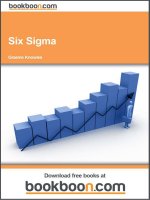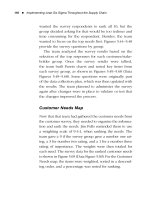Six Sigma program at 3M, Inc. MBA6151 unit IV case study
Bạn đang xem bản rút gọn của tài liệu. Xem và tải ngay bản đầy đủ của tài liệu tại đây (88.91 KB, 6 trang )
Running head: SIX SIGMA PROGRAM AT 3M INC.,
1
Six Sigma program at 3M, Inc.
Le Viet Anh
Columbia Southern University
SIX SIGMA PROGRAM AT 3M INC.,
2
Six Sigma, an analytical and quality control method, was first developed by Motorola to
improve the quality of production, towards excellence in all business operations (Schroeder,
Goldstein, & Rungtusanatham, 2013). This article would like to take a 3M Inc. as an example to
analyze the benefits, risks, and points of interest when applying Six Sigma in the enterprise.
Benefits, Costs, and Risks of the Six Sigma program
Six Sigma is a systematic approach that uses five basic steps: defining, measuring,
analyzing, improving and controlling to improve the business process or minimize defects found
in the product. The main process of the Six Sigma is the DMAIC model, which deals with
defining problems through the voice of the customer and then finds a way to measure and control
the same (Shankar, 2009).
Some typical benefits of Six Sigma are increased customer satisfaction, fueling and
activating the organization's operations, improving product quality, service and process. 3M's use
of Six Sigma will help the company achieve the benefits of using advanced technology and
modern media. By addressing outstanding issues and solve them, it will increase the company's
sales, management efficiency, and ensure organizational sustainable growth. By implementing a
streamlined and efficient process, the company will save resources and minimize defects, thereby
increasing profitability. In addition, more staff will be trained and they will understand the
procedure better as well as the objective conditions that affect the implementation of the
procedure. In the case the current company does not have existing processes, the Six Sigma will
be used as a process to guide and develop other processes.
The cost of executing the Six Sigma is quite high, as it is usually done on dedicated
leaders, vice presidents, or selected employees to train them to become "black belts," also known
SIX SIGMA PROGRAM AT 3M INC.,
3
as full time process improvement specialists. It will become even more costly when this training
lasts up to 4 weeks with ongoing expenses and trainee need to leave their daily work. These costs
are mainly for training and management. In the case of 3M, the company conducted training
programs in 2000 with about 4000 people involved in the project. With large numbers of
participants and large costs, large enterprises can afford and will achieve high efficiency when
applied, but small businesses need to consider carefully the advance capital for the project. The
balance between cash flow and efficiency needs to be carefully discussed before proceeding.
The risk of the program lies in the high cost, complexity of the program, and the
difficulty in measuring results for service processes and transaction-based processes (Kubiak,
2012). Firstly, if a program is not fully evaluated and controlled, then resulting in
ineffectiveness, the company will lose a large amount of money. Next, the complexity of the
program requires companies to provide specific instructions to employees. Any lack of
information can lead to ineffectiveness of the whole program. Finally, if the business is
intangible, the Six Sigma will not be able to evaluate its performance directly. The Six Sigma
also focuses primarily on product orientation with the least error and variation. This can put
pressure on and hinder the process of product improvement and innovation.
Involvement of functional departments in the Six Sigma initiatives
The main purpose of the Six Sigma is to use DMAIC and identify problems with an
organization. This process requires the involvement of all departments and related functions with
the end result of improving the quality of a product. Different departments within the
organization will have different approaches but they have a common implementation schedule
that includes identifying specific current issues, measuring, analyzing, improving and
SIX SIGMA PROGRAM AT 3M INC.,
4
controlling. This will enhance the ability of all parts of the company as well as the linkage
between the parts. Since this is a senior management strategy for improving the current process
or developing new processes, senior management plays an important role in implementing Six
Sigma. Managers at the middle level serve as a bridge between management and staff so their
role is equally important.
In short, applying Six Sigma must be done systematically throughout the entire system.
For management tasks, the responsibility belongs to senior management, black belt. Middle level
managers will receive policy from the black belt and carry out the work at the bottom.
Implications of the human resource for the deployment of Six Sigma
The reason that human resources departments need to implement Six Sigma is to ensure
that they will hire the right people, for the right position, at the right time and in the right way to
maintain and develop those people (Bloom, 2016). By applying this, it allows HR to reject
applicants that are not suitable for the company. Although most staff will be trained to make at
least a blue belt, all teams will need a black belt, as a leader, to help improve the team.
In addition, the Six Sigma also plays an important role in the organizational structure as
there will be many divisions to discuss and work on and agree on a specific process. The
functional structure of the business describes the flow of information communicated between
different levels within an organization, but it does not guarantee cohesion between members, the
workflow or process itself will solve that problem. In addition, the combination of functional
departments can also be changed to suit the conditions, to ensure their work and responsibilities.
Moreover, the reward system also plays an important part in improving the quality of
work of employees (Bloom, 2016). This program will select personnel for each department and
SIX SIGMA PROGRAM AT 3M INC.,
5
apply appropriate financial incentives to motivate employees to contribute to the company. Once
the motivation is large enough, the employee will try to accomplish the task assigned with high
quality, even beyond the expectation of management.
Recommendations on Six Sigma deployments at 3M, Inc.
Six Sigma will affect the culture of innovation at 3M as it is quite strict, and tends to
prevent the flexibility and innovation in creating and developing new products (Schroeder,
Goldstein, & Rungtusanatham, 2013). Powerful restrictions will help prevent production defects
but it does not allow the company to take the necessary risks to create something new, as 3M has
ever had. It will be necessary for the company to balance the Six Sigma and creativity.
Over the past hundred years of innovation and development, 3M has repeatedly achieved
significant sales growth. Most of that growth comes from research and development of new
products. Applying Six Sigma to improve the process is essential for the company to be able to
operate stably and to handle the burden of management. However, this should not be considered
as a solution for all phases of operation. The company needs to study the Six Sigma more closely
to find an organizational structure that can support the development of the process while giving
room for innovation and creativity.
SIX SIGMA PROGRAM AT 3M INC.,
6
References
Bloom, D. (2016). The Field Guide to Achieving HR Excellence through Six Sigma. Boca Raton,
FL: CRC Press.
Kubiak, T. M. (2012). The Certified Six Sigma Master Black Belt Handbook. Milwaukee, WI:
ASQ Quality Press.
Schroeder, R. G., Goldstein, S. M., & Rungtusanatham, M. J. (2013). Operations Management
in the Supply Chain: Decisions and Cases, 6th ed. New York, NY: McGraw-Hill.
Shankar, R. (2009). Process Improvement Using Six Sigma: A DMAIC Guide. Milwaukee, WI :
ASQ Quality Press.









